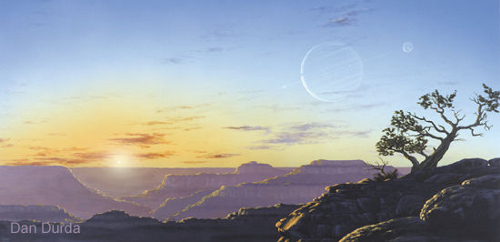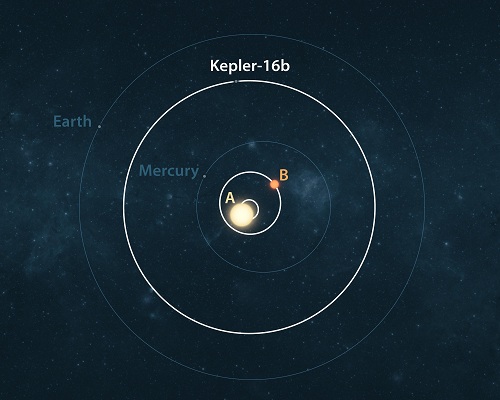Centauri Dreams
Imagining and Planning Interstellar Exploration
Exoplanetary Ring Systems and Their Uses
What to say about an extrasolar ring system that has already had its four distinct rings named? Rochester, Sutherland, Campanas and Tololo are the Earth-bound sites where the unusual system was first detected and analyzed, and the international team of researchers involved thought them suitable monickers for the four rings thus far detected. The light curve of the young, Sun-like star they’ve been studying in the Scorpius-Centaurus association — a region of massive star formation — shows what appears to be a dust ring system orbiting a smaller companion occulting the star.
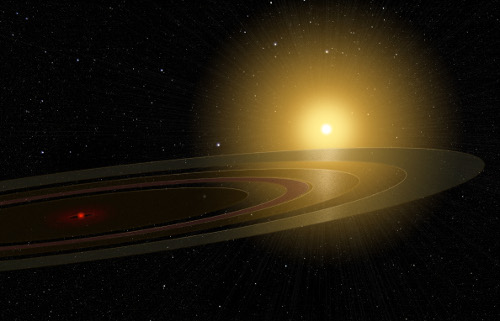
The data here come from SuperWASP (Wide Angle Search for Planets) and the All Sky Automated Survey (ASAS) project. The star in question is 1SWASP J140747.93-394542.6, which displays a complex eclipse event with, at some points, 95 percent of the light from the star being blocked by dust. Similar in mass to the Sun, the star is only about 16 million years old, and lies about 420 light years away from the Solar System. Eric Mamajek (University of Rochester) thinks the object at the center of the system is either a low-mass star, a brown dwarf, or a planet, but it will take follow-up studies to determine the answer. Says Mamajek:
“When I first saw the light curve, I knew we had found a very weird and unique object. After we ruled out the eclipse being due to a spherical star or a circumstellar disk passing in front of the star, I realized that the only plausible explanation was some sort of dust ring system orbiting a smaller companion—basically a ‘Saturn on steroids.’ This marks the first time astronomers have detected an extrasolar ring system transiting a Sun-like star, and the first system of discrete, thin, dust rings detected around a very low-mass object outside of our solar system.”
Image: Rings found in a young stellar system may offer clues to planet formation, including the moons around gas giants. Credit: Michael Osadciw/University of Rochester.
The discovery is unusual but it’s not likely to be our last look at such systems. A circumstellar disk can have a huge radius, and we can imagine seeing one star in a binary system with such a disk that would regularly eclipse the other star. The same is true of a giant planet in a young system that is building moons out of its own circumplanetary disk. Seeing such disks in eclipse could tell us much about the era of planet formation, and we already have long-period eclipsing systems like EE Cephei, Epsilon Aurigae and OGLE-LMC-ECL-17782 to build on. In fact, the eclipses associated with Epsilon Aurigae last almost 2 years, and we may be seeing “…rings and gaps in a forming planetary system around a lower mass secondary,” as the paper on this work notes.
But we could also be looking at moons in formation around a gas giant, a subject that calls up our recent discussion of the HEK (Hunt for Exomoons with Kepler) project and the detectability of these objects. The exomoon discussion in the paper is worthy of an extended quote:
A simple thought experiment illustrates the potential observability of moon-forming circumplanetary disks around young gas giants (and indeed this was the back of the envelope calculation that spawned our interest in the interpretation of the eclipsing star)… If one were [to] take the Galilean satellites of Jupiter and grind them up into dust grains, and spread the grains uniformly between Jupiter and Callisto’s orbit, one would have a dusty disk of optical depth O(105). The size of such a proto-moon disk in this case would be a few solar radii – i.e. large enough and optically thick enough to potentially eclipse a star’s light. Of course such a disk need not be face on – more likely the disk would have a nonzero inclination with respect to the planet-star orbital plane, so the star need not be completely geometrically eclipsed by such a circumplanetary disk.
Relating this to our own system, the paper goes on:
The rings of Saturn have optical depth near ?1 even at a relatively old age (4.6 Gyr), however the vast majority of mass orbiting Saturn is locked up in satellites (Mrings ? 10?4 Msatellites). Presumably a disk of much higher optical depth and signi?cant radial substructure existed during the epoch of satellite formation. While there have been studies investigating the detectability of thin, discrete planetary rings similar to Saturn’s… there has been negligible investigation of the observability of the dense proto-satellite disks that likely existed during the ?rst ?107 years. Relaxing the assumptions about the size, mass, composition and structure of the disk in our back-of-the-envelope calculation has little impact on the feasibility of the idea that dusty disks of high optical depth may be a common feature of young gas giant planets, and such objects may be observable via deep eclipses of young stars.
Putting all this together, our knowledge of the moons of gas giants in our own Solar System tells us that when they were in formation, circumplanetary disks would have produced equally complex eclipses if seen in transit by distant astronomers, showing dense areas alternating with gaps where the young moons were in the process of formation. Viewing such events around exoplanets, then, we may be seeing a testbed for moon and planet formation theories that will become increasingly more valuable as the number of such disk observations increases.
The paper is Mamajek et al., “Planetary Construction Zones in Occultation: Discovery of an Extrasolar Ring System Transiting a Young Sun-like Star and Future Prospects for Detecting Eclipses by Circumsecondary and Circumplanetary Disks,” in press at the Astronomical Journal (preprint).

Circumbinary Planets: A New Class of Systems?
Last week’s meeting of the American Astronomical Society is still much in the news, and I want to cover several more stories from the Austin conclave this week, starting with yet another circumbinary planetary system, in which a planet orbits two stars. Not long ago we looked at Kepler-16b, a circumbinary planet orbiting two stars in this mode — as opposed to a binary system where planets orbit one or the other of the two stars. Kepler-16b was interesting but perhaps unusual given the perceived difficulties in finding stable orbits around close binaries.
But things are happening quickly on the exoplanet front. Needing more information about the prevalence of this kind of planet and the range of orbital and physical properties involved in such systems, we now get news of not one but two more, Kepler-34b and Kepler-35b. Note the nomenclature: We could as easily call these Kepler-34(AB)b and Kepler-35(AB)b. We confront the real possibility that ‘two sun’ systems are not necessarily rarities. At least, that’s the view of William Welsh (San Diego State University), who presented the findings at the AAS meeting:
“It was once believed that the environment around a pair of stars would be too chaotic for a circumbinary planet to form, but now that we have confirmed three such planets, we know that it is possible, if not probable, that there are at least millions in the Galaxy.”
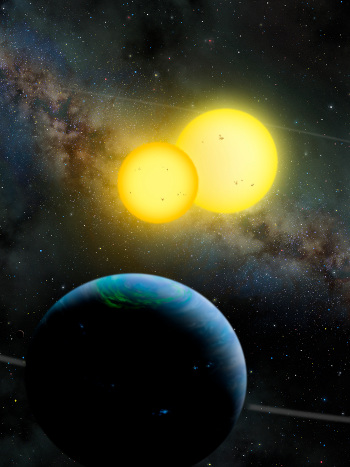
Here’s what we know about these worlds. Kepler-34b orbits two Sun-like stars every 289 days, while the two stars in question orbit and eclipse each other every 28 days. At 4,900 light years from Earth, the planet is in the constellation Cygnus, as is Kepler-35b, although the latter is more distant at 5400 light years. Both are thought to be Saturn-sized gas giants. Kepler-35b orbits its two stars (80 and 89 percent of the Sun’s mass) every 131 days, with its central stars orbiting and eclipsing each other every 21 days. Between these worlds and Kepler-16b, we are building our knowledge of a new class of planets, one Kepler may supplement with still more examples.
Image: Twin suns would yield not only spectacular visual effects but climate changes that could be equally breathtaking. Credit: Lynette R. Cook.
Laurance Doyle (SETI Institute), a co-author of the paper on this work, speaks of “…the new field of comparative circumbinary planetology,” which he believes is now established by these findings. Here is yet more fodder for science fiction writers looking for unique settings, for planets in such orbits would receive continually changing amounts of sunlight. The effects on local weather patterns alone would be enough to spin an absorbing tale, a year’s worth of seasonal change packed into short and dramatically changing time frames. “The effects of these climate swings on the atmospheric dynamics, and ultimately on the evolution of life on habitable circumbinary planets,” says Welsh, “is a fascinating topic that we are just beginning to explore.”
The paper is Welsh et al., “Transiting circumbinary planets Kepler-34 b and Kepler-35 b,” published online by Nature on 11 January, 2012 (abstract).

New Exomoon Project Will Use Kepler Data
Exomoons are drawing more interest all the time. It may seem fantastic that we should be able to find moons around planets circling other stars, but the methods are under active investigation and may well yield results soon. Now David Kipping (Harvard-Smithsonian Center for Astrophysics) and colleagues have formed a new project called HEK — the Hunt for Exomoons with Kepler. We thus move into fertile hunting ground, for there has never been a systematic search for exomoons despite the work of ground-breaking researchers like Kipping, Gaspar Bakos (Princeton) and Jean Schneider (Paris Observatory). It’s definitely time for HEK as Kepler’s exoplanet candidate list grows.
Kepler, of course, works with transit methods, noting the dip in starlight as an exoplanet passes in front of the star under observation. HEK will use Kepler photometry to look for perturbations in the motion of the host planet that could flag the presence of a moon. Variations in transit timing (TTV) and duration (TDV) should be the most observable effects, the former being variations in the time it takes the planet to transit its star, while transit duration variation is caused by velocity changes induced by the fact that the planet and moon orbit a common center of mass.
The team will also look for eclipse features, where the moon might occult the planet during a planet-star eclipse. Back in 2009, Kipping and team ran a feasibility study on Kepler’s ability to find the moon of a gas giant in the habitable zone of a star (see Habitable Moons and Kepler). Assuming moons on circular, coplanar orbits around the host planet, the results showed that Kepler could detect exomoons down to 0.2 Earth masses. This is a large moon indeed, for as Kipping’s new paper on this work points out, the most massive moon in our Solar System, Ganymede, is 0.025 Earth masses (our own Moon is 0.0123 Earth masses). No question, then, that HEK will be looking for large moons, moons bigger than any we see in our own system.
Image: The view from a large exomoon would be like nothing we’ve seen in our own system, especially if that world proved suitable for life. Credit: Dan Durda.
Of course, binary planets also fall within the scope of this study — Kipping draws the line between a binary planet and a true planet-moon pair at the point where the center of mass of the two bodies is outside the radius of both bodies, but HEK can work comfortably with both scenarios. The paper runs through the likelihood that such large objects might exist, forming either around the host planet as it undergoes planetary growth, or (more likely) being captured by the host — here we think of moons like Triton in our own system, or of impact scenarios between planetesimals or young planets like that thought to have produced our own Moon.
Other scenarios are also possible, as the paper announcing HEK notes:
For planets which do not migrate through a proto-Kuiper belt or under the assumption that such objects will never reach su?cient mass to qualify as large moons, an alternative source of terrestrial mass objects is required. This object could be an inner terrestrial planet encountered during the gas giant’s inward migration or even a large, unstable Trojan which librates too close to the planet. Indeed, Eberle et al. (2010) have shown that a gas giant planet (in their case HD 23079b) can capture an Earth-mass Trojan into a stable satellite orbit, occurring in 1 out of the 37 simulations they ran.
How long would such a system be stable? The capture process would produce what the paper describes as ‘very loosely-bound initial orbits,’ but there has been work showing that captured moons have relatively high survival rates, as high as 50 percent in various configurations. Producing binary planets through the same methods is plausible, and the paper notes that a Jupiter orbited by an Earth-class planet could be considered an example of an extreme binary.
Examining these origin scenarios as well as the evolution of large moons in detail, the paper goes on to note the project’s objectives:
1. The primary objective of HEK is to search for signatures of extrasolar moons in transiting systems.
2. The secondary objective of HEK will be to derive posterior distributions, marginalised over the entire prior volume, for a putative exomoon’s mass and radius, which may be used to place upper limits on such terms (where conditions permit such a deduction).
3. The tertiary objective of HEK is to determine… the frequency of large moons bound to the Kepler planetary candidates which could feasibly host such an object (in an analogous manner to ?? – the frequency of Earth-like planets).
We know that in our own system, Europa, Titan and even tiny Enceladus are possible candidates for life. The Hunt for Exomoons with Kepler project won’t be able to tell us anything about astrobiology on an exoplanet’s moon, but if we begin to find Earth-sized objects orbiting gas giants in the habitable zone, we’ll have taken a first step toward learning whether exomoons could be just as viable a place for life as a planetary surface. The HEK home page goes so far as to speculate that planet-based life could actually be outnumbered by life on habitable moons. Step one, of course, is to find out if such moons actually exist, using Kepler’s crucial data.
The paper is Kipping et al., “The Hunt for Exomoons with Kepler (HEK): I. Description of a New Observational Project,” submitted to the Astrophysical Journal (preprint). The 2009 study is Kipping et al., “On the detectability of habitable exomoons with Kepler-class photometry,” Monthly Notices of the Royal Astronomical Society, published online 24 September, 2009 (abstract).

Three Exoplanets Smaller than Earth
It’s always gratifying to note the contributions of amateur astronomers to front-line science. In the case of three small planets discovered around the Kepler star KOI-961, the kudos go to Kevin Apps, now a co-author of a paper on the new work. It was Apps who put postdoc Philip Muirhead (Caltech) on to the idea that KOI-961, a red dwarf, was quite similar to another red dwarf, the well-characterized Barnard’s Star, some six light years away in the constellation Ophiuchus. It was a useful idea, because we do have accurate estimates of Barnard Star’s size, and the size of the star becomes a key factor in exoplanet detections.
For the depth of a light curve — the dimming of the star over time due to the passage of planets across its surface as seen from Kepler — reveals the size of the respective planets. Researchers from Vanderbilt University aided the Caltech team in determining KOI-961’s size, a difficult call because while Kepler offers data about a star’s diameter, that data is considered unreliable for red dwarfs. Detailed spectra from both Palomar and Keck showed that Kevin Apps was right. “When we compared its fingerprint with those of the best known M dwarfs we found that Barnard’s Star was the best match,” says Vanderbilt astronomer Keivan Stassun.
Having established the size, mass and luminosity of KOI-961, the team could calculate the size and characteristics of the planets around it. Confirming three planets that are actually smaller than Earth took intensive follow-up, using photographs taken with the Palomar Observatory’s Samuel Oschin Telescope in 1951. KOI-961 is in Cygnus about 130 light years away, close enough to show motion in the time period involved, and it was clear from studying the photographs that no background stars could have accounted for the light curves.
We wind up with three small exoplanets that range in size from 0.57 to 0.78 times the radius of Earth. The primary is only about 70 percent bigger than Jupiter, but all three of the planets are so close to it that their temperatures are expected to range from 200 degrees Celsius for the outermost planet up to 500 degrees Celsius for the innermost. The entire system is small enough that Caltech astronomer John Johnson compares it to Jupiter and its moons, adding “This is causing me to have to fully recalibrate my notion of planetary and stellar systems.”
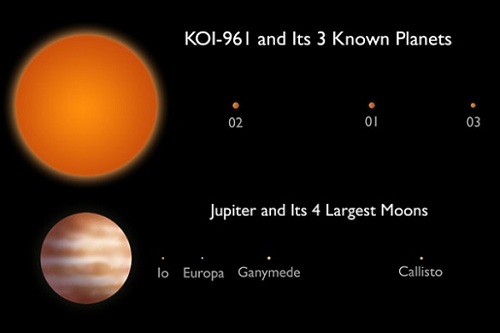
Image: This artist’s conception compares the KOI-961 planetary system to Jupiter and the largest four of its moons. The KOI-961 system hosts the three smallest planets known to orbit a star beyond our sun (called KOI-961.01, KOI-961.02 and KOI-961.03). The planet and moon orbits are drawn to the same scale. The sizes of the stars, planets and moons have been increased for visibility. Credit: Caltech.
All three planets are thought to be rocky, so small that only such a composition would allow them to hold together. And while the three are obviously not habitable, the fact that we’re now finding small worlds around red dwarfs has undeniable implications. Johnson again:
“Red dwarfs make up eight out of every ten stars in the galaxy. That boosts the chances of other life being in the universe—that’s the ultimate result here. If these planets are as common as they appear—and because red dwarfs themselves are so common—then the whole galaxy must be just swarming with little habitable planets around faint red dwarfs.”
After all, while Kepler reported 900 exoplanet candidates in February, only 85 or so were in red dwarf systems, a small sample but one that is already producing planets. The vast numbers of red dwarfs in the Milky Way thus gain further interest as possible sites for life, although as we’ve discussed many times in these pages, huge issues remain, such as tidal locking and the flare activity often found in younger red dwarfs. We can expect continuing study of the question of whether a rocky world in the habitable zone of such a star could offer life a viable foothold.
Ongoing red dwarf studies will add to our picture of the prevalence of such planets, as the paper on this work notes:
Combined with the low probability of a planetary system being geometrically aligned such that a transit is observed (only 13% in the case of KOI 961.01), Kepler’s discovery of planets around KOI 961 could be an indication that planets are common around mid-to-late M dwarfs, or at least not rare. This would be consistent with the results of Howard et al. (2011), who used the Kepler detections to show that the frequency of sub-Neptune-size planets (RP = 2-4 R?) increases with decreasing stellar e?ective temperature for stars earlier than M0. Results from on-going exoplanet surveys of M dwarfs such as MEarth (e.g. Irwin et al. 2011b), and future programs such as the Habitable Zone Planet Finder (e.g. Mahadevan et al. 2010; Ramsey et al. 2008) and CARMENES (Quirrenbach et al. 2010), will shed light on the statistics of low-mass planets around mid and later M dwarfs.
And what of Barnard’s Star itself? This Vanderbilt news release discusses the star’s appearance in televised science fiction but misses the wonderful use Robert Forward made of it in Rocheworld, a novel he wrote to illustrate his concept of ‘staged’ laser sails carrying a manned mission to the stars. In any case, the idea of planets around Barnard’s Star is not new. It was in the late 1960s that Peter van de Kamp announced what he thought were two gas giants in orbit around the star, but neither planet could be confirmed and the detection is now thought to have been the result of a systematic error produced by van de Kamp’s equipment.
Nonetheless, while we’ve been able to exclude planets larger than about five Earth masses within 1.8 AU of the star, Barnard’s Star could still have smaller undetected planets. Doubtless the steadily growing interest in red dwarfs will result in further studies of this nearby target.
The paper is Muirhead et al., “Characterizing the Cool KOIs III. KOI-961: A Small Star with Large Proper Motion and Three Small Planets,” accepted at the Astrophysical Journal (abstract).

Planets by the Billions in Milky Way
People sometimes ask why we are spending so much time searching for planets that are so far away. The question refers to the Kepler mission and the fact that the distance to its target stars is generally 600 to 3,000 light years. In fact, fewer than one percent of the stars Kepler is examining out along the Orion arm are closer than 600 light years. The reason: Kepler is all about statistics, and our ability to learn how common exoplanets and in particular terrestrial planets are in the aggregate. The last thing the Kepler team is thinking about is targets for a future interstellar probe.
Studies of closer stars continue — we have three ongoing searches for planets around the Alpha Centauri stars, for example. But there is so much we still have to learn about the overall disposition of planets in our galaxy. New work by an international team of astronomers involves gravitational microlensing to answer some of these questions, and the results suggest that planets — even warm, terrestrial ones — are out there in vast numbers. Here again statistical analysis plays a crucial role, in conjunction with other forms of exoplanet detection. Arnaud Cassan (Institut d?Astrophysique de Paris) is lead author of the paper on this work in Nature:
“We have searched for evidence for exoplanets in six years of microlensing observations. Remarkably, these data show that planets are more common than stars in our galaxy. We also found that lighter planets, such as super-Earths or cool Neptunes, must be more common than heavier ones.”
Gravitational microlensing is yet another tool in the exoplanet hunt, and an extremely useful one because it gets around some of the limitations of the other major methods. Radial velocity studies tend to favor large planets that are close to their star, although with time and improving techniques, we’re using RV to learn about smaller and more distant worlds. Transit studies like Kepler’s are powerful but take time, as we wait for lengthy planetary orbits to be completed and confirm the presence of planets suggested by slight dips in starlight. But microlensing can detect planets over a wide mass range and also spot planets much further from their stars.
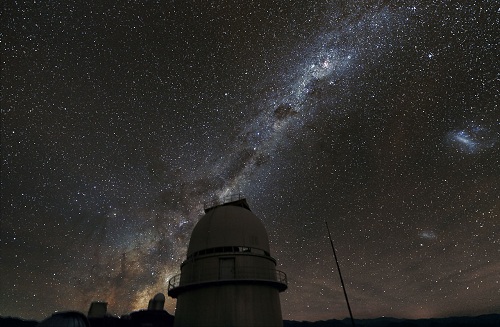
Image: The Milky Way above the dome of the Danish 1.54-metre telescope at ESO’s La Silla Observatory in Chile. The central part of the Milky Way is visible behind the dome of the ESO 3.6-metre telescope in the distance. On the right the Magellanic Clouds can be seen. This telescope was a major contributor to the PLANET project to search for exoplanets using microlensing. The picture was taken using a normal digital camera with a total exposure time of 15 seconds. Credit: ESO/Z. Bardon/ProjectSoft.
The current work uses data from the PLANET and OGLE microlensing teams, two studies that rely on a foreground star magnifying the light of a much more distant star lined up behind it. If the lensing star also has an orbiting planet, the planet’s effect in brightening the background star is measurable. The method gives us the chance to look for planets at a wide range of distances from the Earth, but it also relies on purely chance alignments that are obviously rare. In fact, from 2002 to 2007, only 3247 such events were identified, with 500 studied at high resolution. All this from a microlensing search that involved millions of stars.
The researchers combined the PLANET and OGLE data with detections from earlier microlensing work and weighed these against non-detections during the six year period of study. They then analyzed these data in conjunction with radial velocity and transit findings. The result: Given the odds against finding planets through these chance celestial alignments, planets must be abundant in the Milky Way. In fact, the researchers conclude that one in six of the stars studied hosts a planet with a Jupiter-class companion, half have planets of Neptune’s mass and two-thirds are likely to have super-Earths. Note that the survey was sensitive to planets with masses ranging from five times the Earth’s up to ten times the mass of Jupiter.
Uffe Gråe Jørgensen is head of the research group in Astrophysics and Planetary Science at the Niels Bohr Institute at the University of Copenhagen:
“Our microlensing data complements the other two methods by identifying small and large planets in the area midway between the transit and radial velocity measurements. Together, the three methods are, for the first time, able to say something about how common our own solar system is, as well as how many stars appear to have Earth-size planets in the orbital area where liquid water could, in principle, exist as lakes, rivers and oceans — that is to say, where life as we know it from Earth could exist in principle.”
Jørgensen goes on to conclude that out of the Milky Way’s 100 billion stars, there are about 10 billion with planets in the habitable zone, “…billions of planets with orbits like Earth and of comparable size to the Earth.” Daniel Kubas (ESO, and co- lead author of the paper), takes all this into account and concludes: “We used to think that the Earth might be unique in our galaxy. But now it seems that there are literally billions of planets with masses similar to Earth orbiting stars in the Milky Way.” Statistics tell the tale, one that will be refined with each new exoplanet detection, but one that points increasingly to a galaxy where Earth-sized planets are common.
The paper is Cassan, Kubas et al., “One or more bound planets per Milky Way star from microlensing observations,” Nature 481, 167–169 (12 January 2012). Abstract available.

Kepler-16b: Inside a Chilly Habitable Zone?
The annual meeting of the American Astronomical Society is now in session in Austin, sure to provide us with interesting fodder for discussion in coming days. Just coming off embargo yesterday was news of further study of the interesting Kepler-16 system. This one made quite a splash last fall when the planet known as Kepler-16b was discovered to orbit two stars, with the inevitable echoes of Star Wars and the twin suns that warmed the planet Tatooine. This planet, though, was a gas giant more reminiscent of chilly Saturn than a cozily terrestrial world.
Image: An artist’s conception of the Kepler-16 system (white) from an overhead view, showing the planet Kepler-16b and the eccentric orbits of the two stars it circles (labeled A and B). For reference, the orbits of our own solar system’s planets Mercury and Earth are shown in blue. New work out of the University of Texas at Arlington explores the question of habitability in a system like this. Credit: NASA/Ames/JPL-Caltech.
You’ll recall, too, that Kepler-16b circles both a K-dwarf with about 70 percent of the Sun’s mass and a red dwarf of about a fifth of a solar mass. Although the planet’s orbit takes it within Venus-like distances of them, Kepler-16b’s central stars are small enough that temperatures would appear to be too cold for life. At the Austin meeting, however, researchers from the University of Texas at Arlington have made the case that an Earth-class planet could exist here as an exomoon orbiting the gas giant. They have no indication that such a planet actually exists, as Zdzislaw Musielak (UT-Arlington) is quick to point out, but the work is interesting nonetheless:
“This is an assessment of the possibilities,” said Musielak. We’re telling them where a planet has to be in the system to be habitable. We’re hoping they will look there.”
Making conditions on such a moon habitable would require an atmosphere with a strong warming effect that could be provided by high levels of greenhouse gases like carbon dioxide or methane. Such an atmosphere would widen what we would normally consider to be the habitable zone around the two stars. Al Jackson noted today in an email from Austin that all kinds of new ways to study Kepler candidates are coming to the fore, and remember that Kepler still has a long way to go before its primary mission is accomplished. As to exomoons, we’ve yet to identify one, but so much good work has been accomplished on how to achieve such a detection that it’s surely not going to be long before we have candidate exomoons to focus in on.
The paper on this work is not yet out, but I’ll announce it here when it’s available. Meanwhile, thoughts on how many habitable worlds are out there continue to be expansive. More on this tomorrow, as we return to news coming out of the Austin conference.

